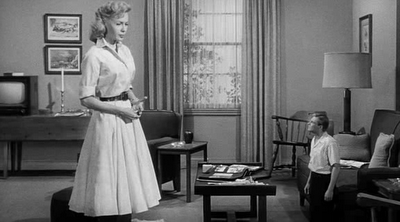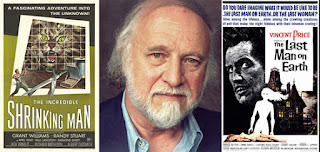 |
| The Twilight Zone - 'Last Flight' |
Like most people, I can't be sure when I first became aware of the work of Richard Matheson. It's a dead certainty that I watched films or TV shows he wrote long before I knew his name. Or rather, before I was consciously aware of it. Because, like those of Charles Beaumont and Robert Bloch, Matheson's name crops up on rather a lot of Roger Corman movies that were undoubtedly televised on the BBC when I was a lad. Were there also Twilight Zone re-runs on the BBC when I was a lad? I wouldn't be surprised. I also remember seeing Spielberg's Duel on TV in the Seventies.
(To digress for a paragraph - it fair to call it that? It is Spielberg's film because he directed it - he is the gifted general who commanded the army of actors, technicians, assorted creative experts and general gofers that are essential to the making of even a small-ish feature film. Whereas Matheson 'just' wrote the story. To draw out the military analogy, the writer is the grand strategist of the campaign, sitting well behind the lines planning future triumphs, while the director is the man who has to struggle with the problems that arise when a beautiful plan - or plot - collides with the realities of filming. So, yes, it is fair. But it's also obviously bad news for screenwriters and goes a long way to explain why they're notoriously underpaid.)
Some things I can be sure of. I first saw The Incredible Shrinking Man and The Omega Man in the Seventies, both on the small screen. Both are by Matheson, both are brilliant, and both about men struggling to survive in a world that has become alien and hostile. Both are classic example of how popular fiction can - at its best - tackle serious issues with imagination and subtlety, sugaring the pill of dangerous ideas with sharp plotting and characterisation.
 |
| Vincent Price in 'The Last Man on Earth' |
Whatever the dehumanised survivors are, though, their existence is not negotiable - the world has been destroyed by the process that created them. The old order cannot be rebuilt, and in the book this is brought home by Matheson is a brutal way that no film producer was willing to countenance. Indeed, in the recent movie the book's whole message is subverted by a weak, 'Go team! We can do this!' ending.
IAL has so much going for it it's hard to know where to begin. Obviously it's a Cold War story - the world could have been destroyed and artificial plagues were very much on the list of terrors at the time, though of course the H-bomb was more photogenic. The vampire-zombies obviously look forward to Romero and the modern Z-craze. And Matheson's insistence that a new type of human could evolve from a global disaster is a clever twist on the superhero genesis stories so common at the time. Instead of one person transformed by a radioactive spider bite, the entire world is rendered problematically in- or at least iso-human by a plague bacillus.
It's good, but The Shrinking Man (that 'incredible' was added by Hollywood) is even better. Here Matheson offers a vision of American man in the Roosevelt era, in theory master of all he surveys, but in practice 'shrinking' to impotence in the face of forces he can't understand, still less control. The real forces were (and remain) those of corporate power, consumerism, media saturation. Matheson rolls them all up into a cloud of sparkly fallout and sets his Everyman on the road to oblivion.
At first it's just weight loss. How many men in the audiences for TISM had been to see 'the doc' because they noticed they'd had to put another hole in their belt? Might it be something serious? Cancer - incurable at the time? The first of many fears is thus introduced quite deftly, and of course the link to the atomic age is right there. Then loss of height becomes an issue - and in the most powerful way. Our Everyman is suddenly the same height as his wife. She is no longer 'the little woman', casting doubt on his status as a man in Fifties America.
The forces of science are marshalled, of course, but we know they'll fail because that's what the movie is about. The fallout that started the process might be analysed, but - as in the non-celluloid world - the genie can't be put back into its bottle. The man continues to shrink - incredibly. We jump forward in time a few months to discover that he is the size of a small boy, fretting and ranting impotently (that word again) while his wife towers above him.
For me, that is the first image that makes TISM a horror movie. Even today it captures the essence of true horror - that the world is not required to be the way we (whoever we might be) fondly believe it must be. We think we understand life, but when reality reminds us that we don't the result is wonder, fantasy, or horror. Horror tends to sell better as it offers more dramatic possibilities. In this case the horror is the realisation that being a man, in the traditional sense of breadwinner, husband, father, protector, is being rendered meaningless by the very progress that is supposed to strengthen and enrich society.
There's a clever twist after this exchange in which we think our man has been restored to normal size. He's living in a house with regular furniture and so forth. This allows the big reveal to be all the more effective - he's a few inches tall and is installed in a dolls' house in his wife's living room. At this point any discerning viewer must ask why she didn't have the cat re-homed. (In the book the cat is an interloper.) But wackiness ensues and our man ends up in the cellar - like a classical hero entering the Underworld, only without apparent hope of discovering anything other than oblivion.
Then comes the bit with the spider. The epic battle for dominance in the vast concrete world of an ordinary suburban cellar is a masterpiece of special effects. It riffs on any number of B-movies about giant monsters that are, essentially, ordinary if ugly beasts made enormous by radiation and eventually defeated by Science with the help of the US military. Matheson's story inverts this familiar idea by showing us how science brings a man down to the level of Nature (offering a polite nod to Darwin, perhaps).
And still he keeps shrinking. The ending of the film and the book offers a vision of transcendence - that a man might be 'king of infinite space' while vanishing from the ken of his world. But really, it's a film that's so good in so many ways, so full of intelligence and humanity, that it deserves to be seen as one of the definitive movies of its era.
And all that before we get on to the supernatural stuff. Not that it's easy to categorise Matheson's work. Take The Legend of Hell House, a riposte to the film The Haunting. Matheson (like Nigel Kneale) considered the latter to be unsatisfying because it failed to explain the reason for the strange phenomena at Hill House. I disagree - I think the explanation lies in the minds of the characters. But Matheson was inspired to produce a rationale for his haunted house that combines sci-fi elements with dark forces that exploit the emotional flaws of his characters. (He tried something similar in his taut 1958 novel A Stir of Echoes.)
The result is a strange and - at times - distinctly sexy movie that, while far from perfect, is an intriguing qualified success.
While no slouch as a novelist, Matheson was a brilliant short story writer, so it's not surprising that much of his most memorable work appeared on TV. The Twilight Zone is rightly revered for its quality and sheer staying power. It became part of the cultural weather in Space Age America, offering futuristic visions as often as quaint nostalgia - and all with a spin that could be either whimsical or deeply disturbing. You were never entirely sure.
Matheson's sixteen TZ scripts are interesting because, while all very different, most epitomise his knack for putting a protagonist in an impossible situation that they must confront or somehow escape from. In 'The Last Flight' a cowardly British pilot is transported from 1917 to 1959 and discovers the possibility of redemption. It's a take of chivalry, in essence, and very old-fashioned. But what makes it work is Matheson's insistence on the moral complexity of a character who is not, even by his own lights, remotely admirable.
'The Invaders', starring Agnes Moorhead (a big name Hollywood star), has the feel of a space age nursery rhyme about the woman who found a flying saucer on her roof. The unspeaking woman's desperate attempts to fend off tiny aliens with ray guns are almost comical, but not quite. The idea of small, clever things scuttling about, plotting our destruction, is an inversion of the Shrinking Man theme.
Arguably the best Matheson story for TZ is 'Night Call', directed by Jacques Tourneur. Here the impossible situation is that of an old woman who receives a series of anonymous phone calls. It emerges that they are from her lover, a young man killed by her arrogance. The accident that led to his death also confined her to bed as a cripple. The ending is, to say the least, downbeat. Overall it's a classic instance of the way Matheson - like Bradbury and others of that generation - could revitalise Gothic conventions with modern plot devices.
Then there are what I like to think of as The Two Shatners. (Matheson also scripted the Star Trek episode 'The Enemy Within', which sees Shatner split into two by a dodgy transporter.) The first is 'Nick of Time', in which a young honeymoon couple are stuck in a small town with car trouble. The husband becomes intrigued with a cheap fortune telling gizmo at a diner, and starts to obsess about feeding it pennies to map out his future. The ending is classic Matheson - very simple, totally effective.
'Nightmare at 20,000 Feet' is rightly considered a classic, overcoming all the contemporary restrictions on visual effects to produce a sort of modern fairy tale - bearing in mind that fairy tales were often very nasty indeed. In a way, this is another tale of aviation and chivalry, given that Shatner's character sacrifices himself for others. And, yes, being a mite immature I always chortle to myself when The Shatster is strapped into a straitjacket at the end. 'Khaaaaannnn!!!'
There's so much more to say about Richard Matheson. I haven't mentioned the other films, the other novels (especially Earthbound), the huge number of short stories, the TV work on many series. And he was a brilliant film adapter, working with Roger Corman and others. Suffice to say that I'll be celebrating Richard Matheson's life this evening, and for many evenings to come, by watching his words come to life on my small screen.







No comments:
Post a Comment